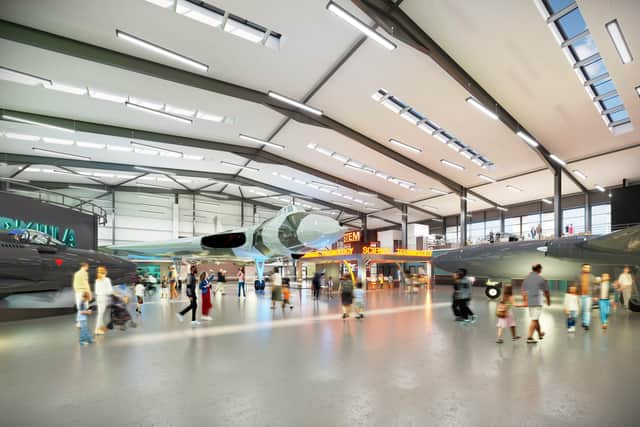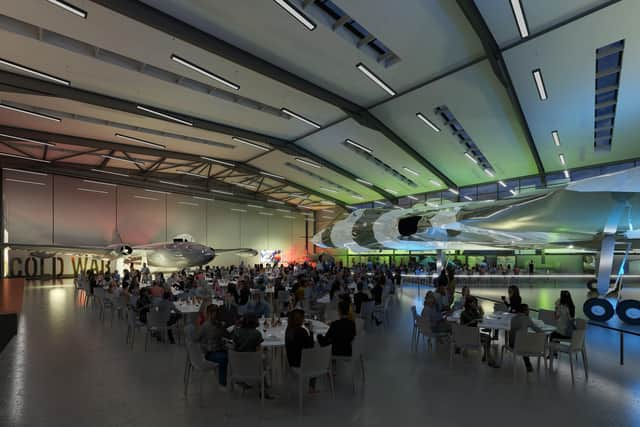Take-off for appeal to finally bring Vulcan bomber out of the cold
The RAF’s delta-winged Vulcan bombers have not been flown in anger since the Falklands War of nearly 40 years ago. But in Doncaster, one final challenge awaits the last of the line.
Some five years after it flew for the last time, The Spirit of Great Britain has become once more the centre of attention with the launch of Operation Safeguard, a campaign to give it a permanent home in a hangar that will be open to all.
Advertisement
Hide AdAdvertisement
Hide AdVolunteers and enthusiasts are hoping to raise £4m to build a visitor centre around the aircraft – officially XH558 – to preserve its legacy as the last of the Vulcans in military service and the last to have been airworthy.


The charity behind the initiative is the Vulcan to the Sky Trust, which in 2007 gave the plane a new, eight-year lease of life at public events and air displays. It is unlikely ever to fly again but since its retirement the organisation has maintained it in taxiable condition at Doncaster Sheffield Airport.
However it will announce today that it is negotiating a mortgage of up to £2.4m towards the cost of a new hangar. A public fundraising campaign, corporate donations and sponsorship will aim to raise the remaining £1.6m.
Dr Robert Pleming, an aviation enthusiast who leads the charity, said the installation of XH558 as a visitor attraction would make the airport “a destination in its own right”, rather than just a terminus from which to arrive and depart.
Advertisement
Hide AdAdvertisement
Hide AdHe said: “From the earliest days of the Vulcan to the Sky Trust’s work, the charity has always had two guiding principles, to honour those who served us in the past and to inspire future generations to make meaningful change in the world.”


The permanent hangar would not only give XH558 a weatherproof home but would incorporate an education centre that would extend to the next generation of aircraft design, he said.
“We have always aimed to inspire youngsters to pursue careers in aerospace and engineering. The innovative 1950s technology of the Vulcan is relatively easy to understand and her awesome power and beauty generates a huge following. We need to inspire youngsters to become the engineers who will devise the required technical solutions to the global climate challenge,” Dr Pleming said.
“Aircraft and air travel using today’s technologies will become unsustainable and if the world is to retain global connectivity, new technical ideas are needed. Some are already on the drawing board.”
Advertisement
Hide AdAdvertisement
Hide AdXH558 made its first test flight on May 25, 1960, at Woodford Aerodrome, not far from Manchester Airport, and since leaving service has been the subject of several preservation appeals. Some £6.5m in public donations and lottery funding saw it restored in flight 13 years ago, for as long as the life expectancy of crucial parts would allow. Over the next eight display seasons, it was seen by an estimated 20 million people. Last year, a fundraising drive anticipated the aircraft’s 60th anniversary by offering donors the chance to have their names etched in vinyl on a commemorative plaque beneath the wings.
The public fundraising drive being launched today asks supporters to donate £50 or £30 each, in return for seeing their names on exhibits in the new exhibition centre, which is scheduled to be ready for the summer of 2022.
Dr Pleming said the facility, which would be “financially viable”, was “a fantastic way to leave a real legacy for the next generation and to help to honour the past, the present and the future”.
Developed in tandem with Britain’s atomic weapons programme, the revolutionary design of the Vulcan bomber made it the last great symbol of British military history and led directly to Concorde and the Space Shuttle.
Advertisement
Hide AdAdvertisement
Hide AdThe Vulcan fleet, which numbered just 136 including prototypes, carried Britain’s strategic nuclear deterrent during much of the Cold War, and the example in Doncaster is one of the few converted for maritime reconnaissance. In 1982, it was pressed into service as an air-to-air refuelling tanker.
Two years later, the last Vulcan squadron was disbanded, leaving only a display Team to briefly fly on.
For the last three years, XH558 has been parked outside Doncaster Sheffield Airport, at the mercy of the weather.The appeal website is at www.vulcantothesky.org.
Support The Yorkshire Post and become a subscriber today.
Your subscription will help us to continue to bring quality news to the people of Yorkshire. In return, you’ll see fewer ads on site, get free access to our app and receive exclusive members-only offers.
Advertisement
Hide AdAdvertisement
Hide AdSo, please – if you can – pay for our work. Just £5 per month is the starting point. If you think that which we are trying to achieve is worth more, you can pay us what you think we are worth. By doing so, you will be investing in something that is becoming increasingly rare. Independent journalism that cares less about right and left and more about right and wrong. Journalism you can trust.
Thank you
James Mitchinson
Comment Guidelines
National World encourages reader discussion on our stories. User feedback, insights and back-and-forth exchanges add a rich layer of context to reporting. Please review our Community Guidelines before commenting.